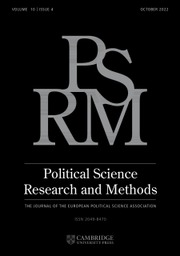Crossref Citations
This article has been cited by the following publications. This list is generated based on data provided by
Crossref.
Ambuehl, Mathias
and
Baumgartner, Michael
2014.
Schneider, Carsten Q.
and
Rohlfing, Ingo
2019.
Set‐theoretic Multimethod Research: The Role of Test Corridors and Conjunctions for Case Selection.
Swiss Political Science Review,
Vol. 25,
Issue. 3,
p.
253.
Haesebrouck, Tim
2019.
An alternative update of the two-step QCA procedure.
Quality & Quantity,
Vol. 53,
Issue. 6,
p.
2765.
Whitaker, Rebecca Garr
Sperber, Nina
Baumgartner, Michael
Thiem, Alrik
Cragun, Deborah
Damschroder, Laura
Miech, Edward J.
Slade, Alecia
and
Birken, Sarah
2020.
Coincidence analysis: a new method for causal inference in implementation science.
Implementation Science,
Vol. 15,
Issue. 1,
Moret, Whitney
and
Lorenzetti, Lara
2020.
Realistic expectations: exploring the sustainability of graduation outcomes in a program for children affected by HIV in Kenya’s Northern Arid Lands.
Vulnerable Children and Youth Studies,
Vol. 15,
Issue. 4,
p.
356.
Coury, Jennifer
Miech, Edward J.
Styer, Patricia
Petrik, Amanda F.
Coates, Kelly E.
Green, Beverly B.
Baldwin, Laura-Mae
Shapiro, Jean A.
and
Coronado, Gloria D.
2021.
What’s the “secret sauce”? How implementation variation affects the success of colorectal cancer screening outreach.
Implementation Science Communications,
Vol. 2,
Issue. 1,
Rendle, Katharine A
and
Beidas, Rinad S
2021.
Four strategic areas to advance equitable implementation of evidence-based practices in cancer care.
Translational Behavioral Medicine,
Vol. 11,
Issue. 11,
p.
1980.
Swiatczak, Martyna Daria
2021.
Towards a neo-configurational theory of intrinsic motivation.
Motivation and Emotion,
Vol. 45,
Issue. 6,
p.
769.
Thiem, Alrik
Mkrtchyan, Lusine
and
Sebechlebská, Zuzana
2022.
Combinational Regularity Analysis (CORA) — a new method for uncovering complex causation in medical and health research.
BMC Medical Research Methodology,
Vol. 22,
Issue. 1,
Rich, John A.
Miech, Edward J.
Bilal, Usama
and
Corbin, Theodore J.
2022.
How education and racial segregation intersect in neighborhoods with persistently low COVID-19 vaccination rates in Philadelphia.
BMC Public Health,
Vol. 22,
Issue. 1,
Thiem, Alrik
Mkrtchyan, Lusine
and
Sebechlebska, Zuzana
2022.
A Phantom Menace: Why Researchers Should Stop Worrying About Logical Remainders in Qualitative Comparative Analysis (QCA).
SSRN Electronic Journal,
Haesebrouck, Tim
and
Thomann, Eva
2022.
Introduction: Causation, inferences, and solution types in configurational comparative methods.
Quality & Quantity,
Vol. 56,
Issue. 4,
p.
1867.
Swiatczak, Martyna Daria
2022.
Different algorithms, different models.
Quality & Quantity,
Vol. 56,
Issue. 4,
p.
1913.
Rich, John A.
Miech, Edward J.
Semenza, Daniel C.
and
Corbin, Theodore J.
2022.
How combinations of state firearm laws link to low firearm suicide and homicide rates: A configurational analysis.
Preventive Medicine,
Vol. 165,
Issue. ,
p.
107262.
Krupnik, Seweryn
and
Koniewski, Maciej
2022.
Choosing a qualitative comparative analysis solution in multi-method impact evaluation.
Evaluation,
Vol. 28,
Issue. 2,
p.
192.
Veri, Francesco
and
Barrowman, Hannah
2022.
The Added Value of Configurational Meta‐analyses.
Swiss Political Science Review,
Vol. 28,
Issue. 1,
p.
116.
Thiem, Alrik
Mkrtchyan, Lusine
and
Sebechlebska, Zuzana
2022.
Combinational Regularity Analysis (CORA) — A New Method for Uncovering Complex Causation.
SSRN Electronic Journal,
Engell, Thomas
Stadnick, Nicole A.
Aarons, Gregory A.
and
Barnett, Miya L.
2023.
Common Elements Approaches to Implementation Research and Practice: Methods and Integration with Intervention Science.
Global Implementation Research and Applications,
Vol. 3,
Issue. 1,
p.
1.
Xu, Wei
Zhu, Xunhong
Zhang, Liping
and
Gao, Jun
2023.
The Iterative Exclusion of Compatible Samples Workflow for Multi-SNP Analysis in Complex Diseases.
Algorithms,
Vol. 16,
Issue. 10,
p.
480.
Nascimento, Esdras
and
Simões Freitas, Jonathan
2023.
Capturando a complexidade causal: Uma abordagem qualitativa formal para pesquisas explicativas.
Metodologias e Aprendizado ,
Vol. 6,
Issue. ,
p.
648.

